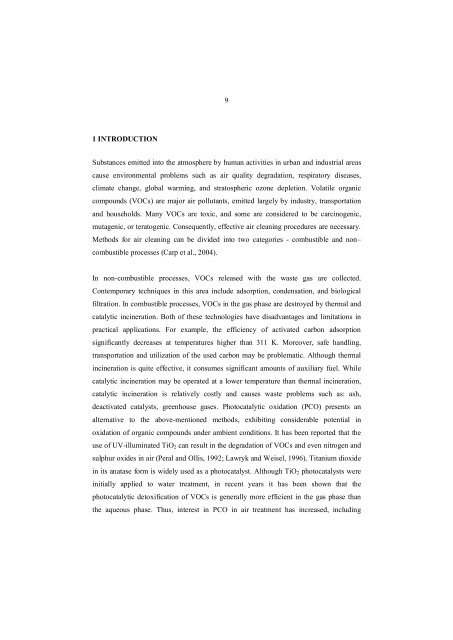gas-phase photocatalytic oxidation of volatile organic ... - Doria
gas-phase photocatalytic oxidation of volatile organic ... - Doria
gas-phase photocatalytic oxidation of volatile organic ... - Doria
Create successful ePaper yourself
Turn your PDF publications into a flip-book with our unique Google optimized e-Paper software.
1 INTRODUCTION<br />
9<br />
Substances emitted into the atmosphere by human activities in urban and industrial areas<br />
cause environmental problems such as air quality degradation, respiratory diseases,<br />
climate change, global warming, and stratospheric ozone depletion. Volatile <strong>organic</strong><br />
compounds (VOCs) are major air pollutants, emitted largely by industry, transportation<br />
and households. Many VOCs are toxic, and some are considered to be carcinogenic,<br />
mutagenic, or teratogenic. Consequently, effective air cleaning procedures are necessary.<br />
Methods for air cleaning can be divided into two categories - combustible and non–<br />
combustible processes (Carp et al., 2004).<br />
In non-combustible processes, VOCs released with the waste <strong>gas</strong> are collected.<br />
Contemporary techniques in this area include adsorption, condensation, and biological<br />
filtration. In combustible processes, VOCs in the <strong>gas</strong> <strong>phase</strong> are destroyed by thermal and<br />
catalytic incineration. Both <strong>of</strong> these technologies have disadvantages and limitations in<br />
practical applications. For example, the efficiency <strong>of</strong> activated carbon adsorption<br />
significantly decreases at temperatures higher than 311 K. Moreover, safe handling,<br />
transportation and utilization <strong>of</strong> the used carbon may be problematic. Although thermal<br />
incineration is quite effective, it consumes significant amounts <strong>of</strong> auxiliary fuel. While<br />
catalytic incineration may be operated at a lower temperature than thermal incineration,<br />
catalytic incineration is relatively costly and causes waste problems such as: ash,<br />
deactivated catalysts, greenhouse <strong>gas</strong>es. Photocatalytic <strong>oxidation</strong> (PCO) presents an<br />
alternative to the above-mentioned methods, exhibiting considerable potential in<br />
<strong>oxidation</strong> <strong>of</strong> <strong>organic</strong> compounds under ambient conditions. It has been reported that the<br />
use <strong>of</strong> UV-illuminated TiO2 can result in the degradation <strong>of</strong> VOCs and even nitrogen and<br />
sulphur oxides in air (Peral and Ollis, 1992; Lawryk and Weisel, 1996). Titanium dioxide<br />
in its anatase form is widely used as a photocatalyst. Although TiO2 photocatalysts were<br />
initially applied to water treatment, in recent years it has been shown that the<br />
<strong>photocatalytic</strong> detoxification <strong>of</strong> VOCs is generally more efficient in the <strong>gas</strong> <strong>phase</strong> than<br />
the aqueous <strong>phase</strong>. Thus, interest in PCO in air treatment has increased, including

















